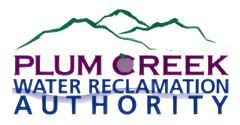About Us
Departments
Plum Creek Water Reclamation Authority consists of 5 distinct departments; all working together to produce a high quality finished product.
Administration:
Plum Creek Water Reclamation Authority is a unique group of people working together for the good of the environment. Our Administration Department strives to participate in this mission in many ways. We are involved in asset management and capital replacement. Our department is involved in working with a financial planner to ensure all capital and general funds are invested safely and in a diverse portfolio. Our department is instrumental in providing accurate information to our auditors on an annual basis and authoring the Comprehensive Annual Financial Report. We also produce a $5M+ annual budget for approval by our Board each year. As with most offices, we perform our daily and monthly tasks such as Accounts Payable and Receivable, and Board meeting preparation, support and financial reporting. In addition to these vital projects, we provide employee support from office supplies and uniforms, to aiding in reporting and research. Everything we do here at PCWRA has an integral part of producing quality effluent. The Administration Department is diligent to contribute in any way we are able.
Operations:
Plum Creek Water Reclamation Authority employs only Colorado State certified operators to operate the plant. For more information on the Colorado certification program please visit the "Operator Certification Program Office" (OCPO).
Plum Creek Water Reclamation Authority is a Biological Nutrient Removal process with a permitted capacity of 6.44 Million Gallons a Day. There are currently two 3.23 million gallon oxidation ditches in operation with two of the three 636,411 gallon clarifiers online. The headworks is equipped with two mechanical stepscreens for the removal of rags and larger objects that make their way to the plant through the collection system. Following the stepscreens are two circular vortex grit chambers designed to remove grit and inorganic settleable solids from the incoming wastewater. After the grit chambers the wastewater enters into one of two oxidation ditches. The oxidation ditch utilizes both anaerobic and anoxic zones for nitrification, denitrification and biological Phosphorus removal. After the treatment in the oxidation ditch the water flows into the secondary clarifiers. These are designed to separate microorganisms from the secondary effluent. The microorganisms are then either returned to the head of the ditch or removed & sent to the aerobic digester. The clarifier effluent is sent to a flocculation tank followed by two tertiary cloth media filters. PCWRA currently uses Ultra-Violet light as the main disinfection for the plant effluent. Microorganisms are collected from the secondary clarifier and pumped to the aerobic digester. Due to the BNR process the microorganisms are usually high in phosphorous. Aerobic digestion reduces the volume of organic matter and pathogenic organisms. After digestion the sludge is dewatered with one of two high solids centrifuge. The liquid or “centrate” that is created from the dewatering process is sent to a storage tank and treated again. The solids or “biosolids” are loaded into trailers and then transported offsite by Parker Ag Services. The biosolids are land applied and incorporated into the soil at the required agronomic rates based on Nitrogen & Total Phosphorus concentrations. The biosolids may be mixed with the biosolids from other Publicly Owned Treatment Works. After the process is complete the finished water is monitored and either released to Plum Creek or sent to one of three golf courses for use in irrigation and grounds keeping.
Check out the MICROORGANISM Page
At Plum Creek Water Reclamation Authority, Operators are also responsible for skilled maintenance work involving preventive and corrective maintenance. Operators are responsible for the maintenance and repair of wide range of mechanical equipment such as pumps, pipes, valves, screening equipment, centrifuges, mixers, filter systems, blowers, chemical feed systems, ultra violet disinfection equipment and other machinery throughout the system. Operations also provides grounds and building maintenance at our facility. We are a team-oriented group that provides a continuous effort to troubleshoot, repair, maintain, and improve our facility.
Laboratory:
The PCWRA laboratory is a full service wastewater laboratory performing over 98 percent of all facility testing in-house. The laboratory is also a Colorado certified laboratory for the testing of Coliforms in Drinking water. The main role of the laboratory at Plum Creek Water Reclamation Authority is to analyze the components of the wastewater at various stages of the treatment process in order to optimize the treatment quality. The laboratory data defines whether regulatory conditions are being met and whether the treated water can be discharged to the aquatic environment as well as be used for golf course irrigation or other reuse applications. The treatment process would not be as efficient and would be much less effective without the daily data received from the laboratory. The laboratory has a critical role in operating a successful water treatment plant.
The laboratory's full list of testing parameters can be found here.
Pretreatment:
Plum Creek Water Reclamation Authority’s Industrial Pretreatment (PCWRA) program is required to prevent commercial and industrial wastewater discharges from adversely affecting the municipal wastewater collection system, Biosolids Quality, PCWRA’s Water Quality and/or its workers.
Plum Creek Water Reclamation Authority’s Code of Rules and Regulations were adopted into the wastewater ordinance in May of 1991. Since the initial adoption, the Rules and Regulations have been amended to now include requirements for grease haulers and restaurants that collect and dispose of grease generated from food service establishments, i.e. Restaurants and commercial kitchens.
Please check out the Pretreatment page for further information and regulatory links associated with the Industrial Pretreatment Program.
